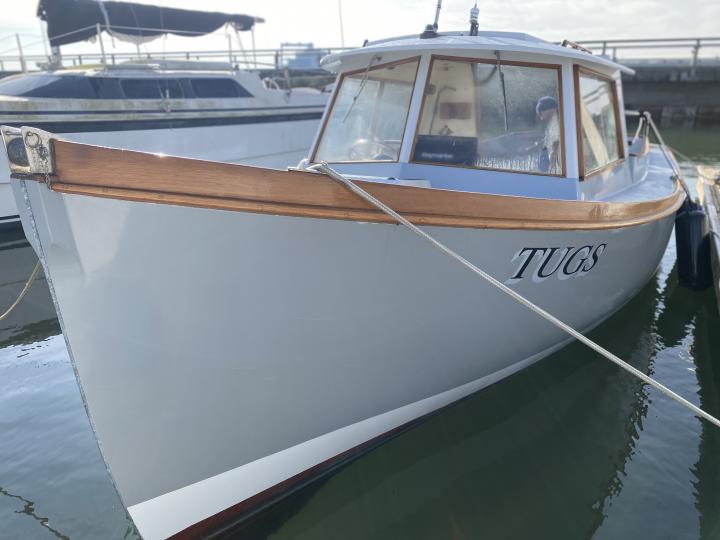
One Man's Boat: TUGS
by John Shinnick, reprinted from a copy of Pacific Yachting, January 1987
Gordon Reed gives you the impression that he's done it all before. A thousand times before. The day is fog-bound, visibility about 200 yards (if that). He backs Tugs out of her Thunderbird Marina slip with the ease that comes from having been here and having done precisely this on thousands of other mornings just like this one.
No hurry, no fuss. The boat's not going anywhere unless Gordon wants it to. On the forward seat, beaming as if he were the owner, sits Timmy, his Belgian Schipperke. Gordon and the dog and the boat are all bound up in one another, each an element in the scheme of things, as integral to this foggy morning as the muted sunlight that manages to somehow illuminate the scene.
Fifty years of commercial boating experience on this coast gave Gordon Reed some pretty specific ideas about what he wanted in a retirement boat. He worked the tugs until the late sixties, and then commissioned a log-salvage boat from the board of William Garden: this boat, Beach Boy, is still a familiar element on the Vancouver waterfront, though now used as a pleasure boat. Tugs - conceived first as a model, and given to Sidney designer Paul Gartside to draw plans - shows Bill Garden's influences in the overhangs on her painted Brunzeel-plywood house.
Built to Gartside's plans by Bent Jespersen of Sidney, Tugs is a sweetie from her pert little upturned stem to her businesslike stern. The lines are clean and functional. There is an economy of means at work here that echoes the workboat. Form follows function, and in this case the function is economical singlehanded passage-making on a protected coast.
Gordon Reed's needs are simple, and Tugs is simple. The hull - sheathed in Dynel and epoxy, painted grey and trimmed with just a touch of teak - is two layers of 1/4 inch cedar, a layer of Honduras mahogany and two extra layers of cedar around the engine compartment. Keel (with 600 lbs of lead) and stem are mahogany.
All-up displacement is 4400 lbs. Pushing the 22ft chugger along is a 30 hp Yanmar 3HM diesel (with Racor filters and Groco raw-water strainers). Reduction gearing between the engine and 18x15-in. prop is 2.83:1. She cruises between 6.73 and 7.07 knots at 2200 to 2400 rpm, burning about 1/2 gallon of fuel per hour for a 350-mile range. A man and a dog can cover a lot of territory in a 350-mile radius. Tankage includes a pair of 20 gallon fuel tanks and 10 gallons of water.
Accommodations are equally simple. The interior is painted an attractive off-white with oiled-teak trim; Gartside describes the upholstery as "oatmeal." To starboard, immediately inside the companionway, the head lies out of sight beneath a small settee. A Dickinson Bristol diesel stove, to port, is fed by a 60-hour daytank on the cockpit bulkhead outside. A sink is just forward of the stove, and a double berth with small coat rack is forward of the inside steering console. This console, in fact, was built from a mock-up that Gordon built to determine just how much room he would need for steering down below. Duplicate Wagner hydraulic steering and Kobelt controls are in the cockpit with a commercial spinner-equipped wheel for close-order drills.
Tugs' sheerline sweeps low, her bow sits high and saucy. The self-bailing cockpit (served by a Chimp hand operated pump, which backs up a Rule electric pump in the bilge) is large for a boat this size. Running across its full inside width is a large gear box for fenders, lines, life jackets and odds and ends.
Everything about this boat bespeaks seaworthiness. All wiring and installations are workmanlike, easy to access and service. The visibility from the lower station is excellent, though Gordon prefers to steer from the partially closed companionway when visibility has been reduced
"My main objective," says Reed, "was a good little seaboat with very little windage." And, judging by how he handled the boat in and out of her slip that morning, I can honestly say that Gordon Reed succeeded.
SPECIFICATIONS
Overall Length: 22ft
Waterline Length: 21ft
Beam: 7ft 6-in.
Draft: 2ft 5-in.
Power: Yanmar Diesel
Prop: 18x15-in.
Cruising rpm range: 2200-2400 rpm
Cruising speed range: 6.73-7.07 knots
Fuel Consumption: 1/2 gal/hr
Dog (Timmy): Schipperke
Tugs was custom built for Gordon Reed by Bent Jespersen of Sidney. For plans, contact Paul Gartside, 10173 Resthaven Drive, Sidney, V8L 3G8
